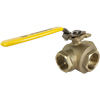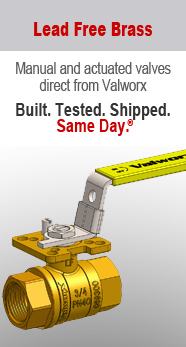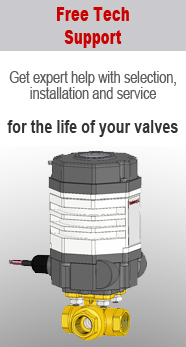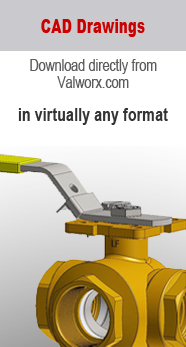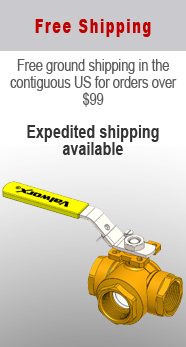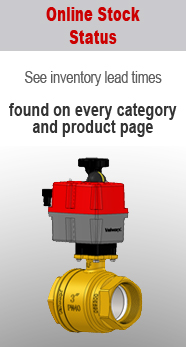Brass
Learn About Brass Ball Valves
Brass ball valves, like all ball valves, control fluid flow by rotating a bored spherical ball to block or open the fluid path. They are available in 2- 3- or 4-way designs and have a variety of end connections.
The primary components of brass are copper and zinc. The ratio of these vary depending on the desired mechanical properties, and additional elements such as tin, iron and lead are sometimes added to further improve certain properties. Of these additional elements, lead is the most common additive as it improves machine-ability.
Lead has a lower melting point than zinc, so it is the last element in the alloy to solidify. It therefore squeezes into casting pores where it acts as a sealing agent and aids in machining by acting as a microscopic chip breaker and tool lubricant.
Unfortunately in the machining process the soft lead is smeared onto the machined surface, greatly increasing the amount of lead potentially available for inadvertent consumption. This is, of course, a significant health concern as brass valves are widely used for potable water. In 2014 the US government passed an amendment to the Federal Safe Drinking Water Act reducing the allowable amount of lead ("lead free") to 0.25%, a marked decrease from the previous standard of 8%. (The People's Republic of California established the 0.25% standard in 2006 and has since extended the ban on lead to nearly all types of brass whether used in potable water or not.)
To address this, brass alloys used in potable water applications are formulated to be "lead free" as defined by the Safe Drinking Water Act. Manufacturers have overcome the machining challenges posed by these alloys, and virtually all brass valves sold in the US for drinking water applications are lead free. Brass valves that meet the lead free criteria are usually certified to a generally accepted standard such as NSF 372. In addition, valves can also be certified as safe for potable water use to a standard such as NSF 61.
To be clear, NSF 372 certifies a product as lead free and NSF 61 certifies a product as safe for potable water. Valves certified as lead free should have "LF" cast or stamped into the valve body. All Valworx brass valves are dual-certified to both standards.

Brass ball valves offer the same mechanical advantages as other ball valves in terms of cycle time and flow rate. Because they are made of relatively low cost metals they cost less than stainless steel valves. However, the tensile strength of brass is about two-thirds that of stainless steel, so stainless valves can withstand higher pressures than comparable brass valves. A typical industrial-grade stainless steel valve has a maximum working pressure of ~1000psi, whereas industrial brass valves are rated for ~600psi.
Brass ball valve components consist of a cast and machined valve body, a machined or soldered spherical ball to block or allow fluid flow, a stem and stem packing, and ball seats to seal the valve.

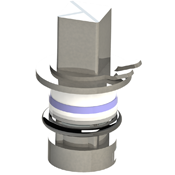
A ball stem engages a slot in the ball which allows the ball to be turned by a handle or actuator. The ball for most brass valves is either plated or solid stainless steel, and the ball itself can be solid or hollow. Higher quality valves use a solid machined ball for smaller sizes and a soldered hollow ball for larger sizes. The extra cost of stainless is justified in higher quality valves because this component is subject to the dynamic stresses of the fluid flow.
All ball valves have valve seats between the ball and the valve body for ball sealing and stem seals (commonly called stem packing) to seal the stem from the ball. In addition, some valve seat designs incorporate spring-loaded seals which compensate for wear and also reduce torque. This type of seal design is commonly referred to as "live loaded" sealing. PTFE (Teflon) and FPM (Viton) are common sealing materials as they are chemically inert with excellent sealing characteristics.
Brass ball valves are connected to piping using threaded ends, brazed or soldered ends, or compression fittings.
Compression fittings accomplish sealing by using a malleable ferrule (such as copper) which is compressed into the female part of the fitting via a threaded connection. In general compression fittings are used for lower pressure applications. Brazed and soldered ends are common in household plumbing applications. As the name implies, the tube end of the valve is soldered or brazed to a pipe of corresponding size. Sealing is accomplished through the solidification of the molten constituents. One drawback of this type of connection is it is difficult to remove the valve if it needs to be replaced. In addition, these installations require, of course, a soldering gun or welding torch.
Threaded connections are the most common for industrial-grade valves as they allow easier removal of the valve and can withstand high pressure. While there are several different thread standards, NPT (National Pipe Thread) is the most common, and this is what we use for Valworx valves.

Brass ball valves can be designed to be easily actuated by casting an integral actuator mounting pad with the valve body. Some manufacturers have their own specific mounting pad designs, but many, including Valworx, use a standard ISO5211 mount. This mounting pattern is widely used throughout the industry and most actuator manufacturers have adopted this standard.

Brass ball valves are commonly used in plumbing, HVAC and industrial applications. They offer a lower cost alternative to stainless steel. They should not be used in potable drinking water applications unless they are certified safe to do so. Also, because they are made primarily of copper, brass valves should not be used in corrosive environments as copper oxidizes readily.
However, given their combination of strength, versatility and lower cost, brass ball valves are the technology of choice in millions of applications worldwide.


